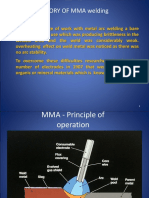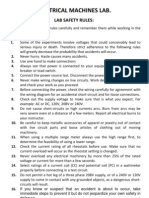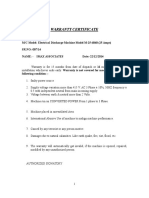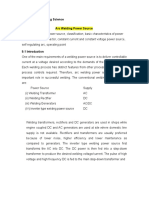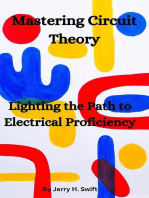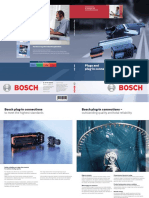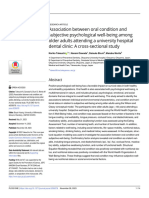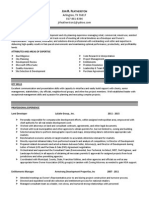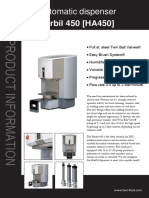Experiment No: 4 Characteristics of Welding Transformer
Experiment No: 4 Characteristics of Welding Transformer
Uploaded by
Kunal TanwarCopyright:
Available Formats
Experiment No: 4 Characteristics of Welding Transformer
Experiment No: 4 Characteristics of Welding Transformer
Uploaded by
Kunal TanwarOriginal Title
Copyright
Available Formats
Share this document
Did you find this document useful?
Is this content inappropriate?
Copyright:
Available Formats
Experiment No: 4 Characteristics of Welding Transformer
Experiment No: 4 Characteristics of Welding Transformer
Uploaded by
Kunal TanwarCopyright:
Available Formats
DELHI TECHNICAL CAMPUS, GREATER NOIDA.
DEPARTMENT OF ELECTRICAL& ELECTRONICS ENGINEERING
Experiment No: 4
CHARACTERISTICS OF WELDING TRANSFORMER
4.1 Objective 4.2 Theory 4.3 Apparatus required 4.4 Connection diagram 4.5 Procedure 4.6 Result 4.7
Precautions.
1.1 OBJECTIVE:
To perform characteristics of welding transformer
1.2 APPARATUS REQUIRED:
S. N. Name of the Equipment Range/Type
1.
AC power supply 440 Volts, 3-Phase
2.
AC Ammeter 60A
3.
AC Voltmeter 500V
4.
Welding Transformer 250A, 2-Phase
5.
Welding Electrode
6.
Welding Holder
7.
Welding Goggles, Apron, Gloves
1.3 CONNECTION DIAGRAM:
EXP No (4) (UEE) Page 1 of 5
DELHI TECHNICAL CAMPUS, GREATER NOIDA. DEPARTMENT OF ELECTRICAL& ELECTRONICS ENGINEERING
1.4 THEORY:
Arc Welding Power Sources:
The main requirement of a power source is to deliver controllable current at a voltage according to the
demands of the welding process being used. Each welding process has distinct differences from one
another, both in the form of process controls required to accomplish a given operating condition and the
consequent demands on the power source. Therefore, arc welding power sources are playing very
important role in welding. The conventional welding power sources are:
Power Source Supply
Power Source Supply
(i) Welding Transformer AC
(ii) Welding Rectifier DC
(iii) Welding Generators AC or DC (Depending on generator)
Welding transformers, rectifiers and DC generators are being used in shop while engine coupled AC
generators as well as sometimes DC generators are used at site where line supply is not available.
Normally rectifiers and transformers are preferred because of low noise, higher efficiency and lower
maintenance as compared to generators. Selection of power source is mainly dependent on welding
process and consumable. The open circuit voltage normally ranges between 70-90 V in case of welding
transformers while in case of rectifiers it is 50-80 V. However, welding voltages are lower as compared
to open circuit voltage of the power source.
EXP No (4) (UEE) Page 2 of 5
DELHI TECHNICAL CAMPUS, GREATER NOIDA. DEPARTMENT OF ELECTRICAL& ELECTRONICS ENGINEERING
Based on the static characteristics power sources can be classified in two categories
1. Constant current or drooping or falling characteristic power source.
2. Constant potential or constant voltage or flat characteristic power source.
Constant voltage power source does not have true constant voltage output. It has a slightly downward or
negative slope because of sufficient internal electrical resistance and inductance in the welding circuit to
cause a minor droop in the output volt ampere characteristics.
With constant voltage power supply the arc voltage is established by setting the output voltage on the
source. The power source shall supply necessary current to melt the electrode at the rate required to
maintain the preset voltage or relative arc length. The speed of electrode drive is used to control the
average welding current. The use of such power source in conjunction with a constant electrode wire
feed results in a self regulating or self adjusting arc length system. Due to some internal or external
fluctuation if the change in welding current occurs, it will automatically increase or decrease the
electrode melting rate to regain the desired arc length.
Fig 4.1: Constant Potential or Constant Voltage or Flat Characteristic.
Fig 4.2: Drooping or Constant current or Falling Characteristic.
EXP No (4) (UEE) Page 3 of 5
DELHI TECHNICAL CAMPUS, GREATER NOIDA. DEPARTMENT OF ELECTRICAL& ELECTRONICS ENGINEERING
The volt ampere output curves for constant current power source are called ‘drooper' because of
substantial downward or negative slope of the curves. The power source may have open circuit voltage
adjustment in addition to output current control. A change in either control will change the slope of the
volt ampere curve. With a change in arc voltage, the change in current is small and, therefore, with a
consumable electrode welding process, electrode melting rate would remain fairly constant with a
change in arc length. These power sources are required for processes using relatively thicker
consumable electrodes which may sometimes get stubbed to workpiece or with nonconsumable tungsten
electrode where during touching of electrode for starting of arc may lead to damage of electrode if
current is unlimited. Under these conditions the short circuiting current shall be limited leading to safety
of power source and the electrode.
Some power sources need high frequency unit to start the arc, which may be requirement of processes
like TIG and plasma arc. High frequency unit is introduced in the welding circuit but in between the
control circuit and HF unit, filters are required so that high frequency may not flow through control
circuit and damage it. High frequency unit is a device which supplies high voltage of the order of few
KV along with high frequency of few KHz with low current. This high voltage ionizes the medium
between electrode and workpiece/nozzle starting pilot arc which ultimately leads to the start of main arc.
Although high voltage may be fatal for the operator but when it is associated with high frequencies then
current does not enter body but it causes only skin effect i.e. current passes through the skin of operator
causing no damage to the operator.
Table 4.1: Welding Processes, Type of Current and Static Characteristic
Static Characteristic of
Welding Process Type of Current
The Power Source
Manual Metal Arc Welding Constant Current
Tungsten Inert Gas Welding Constant Current
Plasma Arc Welding Constant Current
Constant Current
(if electrode = 2.4 mm )
Submerged Arc Welding
Constant Potential
(if electrode = 2.4 mm )
Gas Metal Arc Welding /
Metal Inert Gas Welding / Constant Potential
Metal Active Gas Welding
EXP No (4) (UEE) Page 4 of 5
DELHI TECHNICAL CAMPUS, GREATER NOIDA. DEPARTMENT OF ELECTRICAL& ELECTRONICS ENGINEERING
1.5 PROCEDURE:
(Draw labeled circuit diagram on paper and Arrange all the Equipments & material required for the
practical.)
Step 1: Make the connection as shown in the connection diagram. Keep all the switches in off
position. Phase tapping of the secondary is connected to welding electrode and another end (called
Neutral or NE) is connected to the pieces to be welded.
Step 2: Connections must be checked/verified by the lab staff/faculty, before switch on the Main
supply.
Step 3: After making proper connection, wear welding Goggles, Gloves & Apron and then start
welding
Step 5: Record the readings from measuring instruments carefully carefully.
Step 4: After note down the observations in tabular form, switch OFF the power supply.
1.6 OBSERVATION TABLE:
Open Circuit Voltage VOC :
Short Circuit Current ISC :
Welding Voltage VW :
Welding Current IW :
1.6 RESULT:
Acquaint with the Characteristics of Welding Transformer.
1.7 PRECAUTIONS:
Before switching on the AC supply, connections should be checked by the lab staff.
Do not touch any live wire. Do not keep any joint open.
Use only proper current & voltage rating Equipments.
While working in Electrical lab, kept Safety Rules chart with you.
Don’t forget to use Goggles & Gloves.
EXP No (4) (UEE) Page 5 of 5
You might also like
- A Guide to Electronic Maintenance and RepairsFrom EverandA Guide to Electronic Maintenance and RepairsRating: 4.5 out of 5 stars4.5/5 (7)
- R3215-005041 Appendix A 2.0 - Datasheet For Corrosion CouponDocument1 pageR3215-005041 Appendix A 2.0 - Datasheet For Corrosion Couponsaiful anwarNo ratings yet
- Deep DrawDocument4 pagesDeep DrawBalvinder PrajapatiNo ratings yet
- Experiment No. 01: Operation of Welding Plant Using Transformer 1.1 Learning ObjectiveDocument6 pagesExperiment No. 01: Operation of Welding Plant Using Transformer 1.1 Learning ObjectivePS NNo ratings yet
- WeldingDocument3 pagesWeldingArumugam RajendranNo ratings yet
- MMA Welding LastDocument76 pagesMMA Welding LastMahmoud Elemam100% (1)
- Real-Time Voltage Dip ReductionDocument9 pagesReal-Time Voltage Dip Reductiondipak bhawreNo ratings yet
- Smaw Module LHT-8 and 9Document7 pagesSmaw Module LHT-8 and 9Felix MilanNo ratings yet
- Types of Arc Welding Power Sources - 0Document7 pagesTypes of Arc Welding Power Sources - 0Faiz AhmedNo ratings yet
- Effect of Electrode Regulation System On Arc Parameters in Furnace Operation PDFDocument5 pagesEffect of Electrode Regulation System On Arc Parameters in Furnace Operation PDFSunil KumarNo ratings yet
- Relay and HV Lab-ManualDocument38 pagesRelay and HV Lab-ManualBhavik PrajapatiNo ratings yet
- Arc Welding-1Document14 pagesArc Welding-1m9966822No ratings yet
- Fcaw & Saw W: EldingDocument47 pagesFcaw & Saw W: Eldingprabhatkumar_6657012No ratings yet
- Lab ManualDocument25 pagesLab ManualchaitanyaNo ratings yet
- Shielded Metal Arc Welding Manual Metal Arc Welding Stick WeldingDocument50 pagesShielded Metal Arc Welding Manual Metal Arc Welding Stick WeldingRafli RamadhaniNo ratings yet
- Miller Submerged Arc HandbookDocument32 pagesMiller Submerged Arc Handbookbjrhunter50% (2)
- Green University of Bangladesh: Faculty of Science and EngineeringDocument4 pagesGreen University of Bangladesh: Faculty of Science and EngineeringHaytham KenwayNo ratings yet
- Industrial Electronics: I. Welding SystemsDocument26 pagesIndustrial Electronics: I. Welding SystemsAnthony SosaNo ratings yet
- Effect of Electrode Regulation System Arc Parameters FurnaceDocument5 pagesEffect of Electrode Regulation System Arc Parameters FurnacesophieNo ratings yet
- Power Source Lecture 1Document8 pagesPower Source Lecture 1Sutanwi LahiriNo ratings yet
- Design and Construction of Induction HeaterDocument15 pagesDesign and Construction of Induction HeaterNjitnum100% (1)
- Resistance Spot Welding: Experiment RSWDocument11 pagesResistance Spot Welding: Experiment RSWAli Raza Jutt100% (1)
- Design and Construction of An Electric Arc Welding Machine With Digital Display.Document11 pagesDesign and Construction of An Electric Arc Welding Machine With Digital Display.michael gorgeNo ratings yet
- AC Electric Machines Lab ManulDocument98 pagesAC Electric Machines Lab Manulmuhammad_sarwar_27No ratings yet
- Relays FOR RAILWAY SIGNALINGDocument26 pagesRelays FOR RAILWAY SIGNALINGVikas Srivastav98% (52)
- Manufacturing Processes Lab I MET 1321: Stick WeldingDocument23 pagesManufacturing Processes Lab I MET 1321: Stick WeldingdiszorthNo ratings yet
- Experiment No 1 Spot WeldDocument3 pagesExperiment No 1 Spot WeldAbdullah AbdulwaheedNo ratings yet
- Physics ProjectDocument15 pagesPhysics ProjectYageb AgginNo ratings yet
- NS2 80Document14 pagesNS2 80Luis ROMERONo ratings yet
- Instruction Manual of EDM MachineDocument18 pagesInstruction Manual of EDM MachineJanak ValakiNo ratings yet
- 1.7-Tungsten-Inert Gas WeldingDocument45 pages1.7-Tungsten-Inert Gas WeldingReza DhonyNo ratings yet
- Las Busur KD 4 (32) InggDocument32 pagesLas Busur KD 4 (32) Inggdwisuko12No ratings yet
- PhysicsDocument19 pagesPhysicsbhagyashree062005No ratings yet
- ARC Welding PowARC Welding Power Sources - Pdfer SourcesDocument42 pagesARC Welding PowARC Welding Power Sources - Pdfer SourcesDanielNo ratings yet
- Course: Manufacturing Science Lecture No.: 15 Arc Welding Power SourceDocument10 pagesCourse: Manufacturing Science Lecture No.: 15 Arc Welding Power SourcezombieNo ratings yet
- IM-2000 Operation ManualDocument19 pagesIM-2000 Operation ManualfarduhaNo ratings yet
- Essential Variables of SmawDocument7 pagesEssential Variables of SmawAbdallah Mansour100% (6)
- Eptd Lab ManualDocument32 pagesEptd Lab ManualDeb Swarup67% (3)
- Electronic-Lab 2'Nd Yaer 25Document46 pagesElectronic-Lab 2'Nd Yaer 25hsaab11111No ratings yet
- Tornado - 401 USER MAnDocument11 pagesTornado - 401 USER MAnvipulNo ratings yet
- Beee Lab Manual-2020Document99 pagesBeee Lab Manual-2020venkata karthikNo ratings yet
- Electric Power Voltage: Sag SolutionsDocument14 pagesElectric Power Voltage: Sag SolutionsRamiz RazaNo ratings yet
- SmawDocument15 pagesSmawchella_pandianNo ratings yet
- High Voltage Circuit Breaker PDFDocument4 pagesHigh Voltage Circuit Breaker PDFA.K.A. HajiNo ratings yet
- Design and Construction of An Inverter Type 3kva 50 HZ Single Phase Arc Welding MachineDocument16 pagesDesign and Construction of An Inverter Type 3kva 50 HZ Single Phase Arc Welding Machinejoseph philipNo ratings yet
- Current & Voltage Controlled Welding Transformer (With Load Series Motor)Document5 pagesCurrent & Voltage Controlled Welding Transformer (With Load Series Motor)civilappliNo ratings yet
- Lab 4Document16 pagesLab 4meen19111029 KFUEITNo ratings yet
- 318 ElectricArcWelding PDFDocument40 pages318 ElectricArcWelding PDFtek_surinderNo ratings yet
- 15EI251L E&ilap ManualDocument56 pages15EI251L E&ilap ManualAnushka TantiaNo ratings yet
- Electric Arc Furnace1Document8 pagesElectric Arc Furnace1havejsnjNo ratings yet
- Laboratory Corona Treater Operators Manual: !! Caution !!Document6 pagesLaboratory Corona Treater Operators Manual: !! Caution !!Ahmad D. TaufiqNo ratings yet
- SSG Chapter OneDocument7 pagesSSG Chapter Onekalu chimdiNo ratings yet
- ATS01N209QN: Product DatasheetDocument5 pagesATS01N209QN: Product DatasheethajhdjNo ratings yet
- Set-Up Welding EquipmentsDocument37 pagesSet-Up Welding EquipmentsEvan Jared L. GalvezNo ratings yet
- Welding Arc and Power SourcesDocument52 pagesWelding Arc and Power SourcesSibaram DasNo ratings yet
- Influence of System Parameters Using Fuse Protection of Regenerative DC DrivesFrom EverandInfluence of System Parameters Using Fuse Protection of Regenerative DC DrivesNo ratings yet
- Electricity in Fish Research and Management: Theory and PracticeFrom EverandElectricity in Fish Research and Management: Theory and PracticeNo ratings yet
- Electrical Drives Notes Lecture 1Document4 pagesElectrical Drives Notes Lecture 1Kunal TanwarNo ratings yet
- Dealer Price List AKDocument1 pageDealer Price List AKKunal TanwarNo ratings yet
- Delhii Technical Campus, Greater Noida Department of Electrical& Electronics EngineeringDocument5 pagesDelhii Technical Campus, Greater Noida Department of Electrical& Electronics EngineeringKunal TanwarNo ratings yet
- Experiment No: 6 Verification of Illumination LawsDocument3 pagesExperiment No: 6 Verification of Illumination LawsKunal Tanwar100% (1)
- Ex. 1 UeeDocument48 pagesEx. 1 UeeKunal TanwarNo ratings yet
- Ex 2. To Acquaint With The Charging Methods of Batteries and Calculation of Their Life CycleDocument23 pagesEx 2. To Acquaint With The Charging Methods of Batteries and Calculation of Their Life CycleKunal TanwarNo ratings yet
- Experiment No: 3 Charging and Discharging of Super CapacitorsDocument3 pagesExperiment No: 3 Charging and Discharging of Super CapacitorsKunal TanwarNo ratings yet
- Lighting Design ProcedureDocument25 pagesLighting Design ProcedureKunal TanwarNo ratings yet
- Cosmic Energy NewDocument30 pagesCosmic Energy NewKunal TanwarNo ratings yet
- Cosmic Energy US Patent - 685957Document5 pagesCosmic Energy US Patent - 685957Kunal TanwarNo ratings yet
- Connectors 3 1 PDFDocument246 pagesConnectors 3 1 PDFZian HennNo ratings yet
- Elastic Support Up To 25 KV AC: Sicat 8WL4200 For Overhead Contact Line Systems in Tunnels and Under StructuresDocument4 pagesElastic Support Up To 25 KV AC: Sicat 8WL4200 For Overhead Contact Line Systems in Tunnels and Under StructuresVictor Manuel BonettoNo ratings yet
- Applications of Additive Manufacturing in The Marine IndustryDocument6 pagesApplications of Additive Manufacturing in The Marine IndustryJeeva RathnamNo ratings yet
- Latex All SymbolsDocument98 pagesLatex All SymbolsJeremy van der HeijdenNo ratings yet
- Journal Pone 0295078Document14 pagesJournal Pone 0295078ronaaqilahusnaNo ratings yet
- Solar Panel DocumentationDocument19 pagesSolar Panel DocumentationYogesh ItankarNo ratings yet
- A STUDY On Employee Stress RDocument15 pagesA STUDY On Employee Stress Rchavsnarayana93No ratings yet
- Metro Lite SystemDocument14 pagesMetro Lite SystemAPEXA ARYANo ratings yet
- Colector Analizador de Vibraciones Falcon PDF 2 MBDocument6 pagesColector Analizador de Vibraciones Falcon PDF 2 MBGabriel Alexis MartínezNo ratings yet
- Surface AdditivesDocument24 pagesSurface AdditivesHai PhongNo ratings yet
- Posobie Guide To Analytical Reading HandoutDocument112 pagesPosobie Guide To Analytical Reading HandoutInsomniaNo ratings yet
- Fact Sheet - Electrician (General)Document4 pagesFact Sheet - Electrician (General)Saravanan Rasaya100% (1)
- VP Director Land Development Acquisition in Dallas FT Worth TX Resume Jon FeatherstonDocument2 pagesVP Director Land Development Acquisition in Dallas FT Worth TX Resume Jon FeatherstonJon FeatherstonNo ratings yet
- Forensic Nursing and Indian LawsDocument1 pageForensic Nursing and Indian LawsguruconthiruvallaNo ratings yet
- D-04 Ballast Tank Inspection Report-EnglishDocument2 pagesD-04 Ballast Tank Inspection Report-Englishjajangsuryadilaga76100% (1)
- Docslide - Us Variable Frequency TransformerDocument20 pagesDocslide - Us Variable Frequency TransformerSuhail Ahmad SuhailNo ratings yet
- Passat B5 - Brakes. Technical DataDocument13 pagesPassat B5 - Brakes. Technical DataPedrojzbNo ratings yet
- Grade 7 Math Fractions RecapDocument3 pagesGrade 7 Math Fractions RecapNandini PilaniNo ratings yet
- Chapter 4 OrganizingDocument39 pagesChapter 4 OrganizingHanzel Dy NietesNo ratings yet
- Hilford, Docc - Performing StrongDocument7 pagesHilford, Docc - Performing StrongNLGIIINo ratings yet
- Literacy ToolKIt Author Bradford SchoolsDocument93 pagesLiteracy ToolKIt Author Bradford SchoolsDOA FCLFNo ratings yet
- FM Harbil Ha450Document1 pageFM Harbil Ha450adda.sichelfiNo ratings yet
- Industrial Water Softener: (From 3,2 To 21 M /H)Document2 pagesIndustrial Water Softener: (From 3,2 To 21 M /H)Aadish DileeswarNo ratings yet
- Purcom Unit IIDocument12 pagesPurcom Unit IIjymrprzbtstNo ratings yet
- Psychosocial Status and Quality of Life of Adolescent Girls in Karnataka, IndiaDocument8 pagesPsychosocial Status and Quality of Life of Adolescent Girls in Karnataka, Indiavarunendra pandeyNo ratings yet
- Science Module 2Document9 pagesScience Module 2Prince Mhar SurioNo ratings yet
- 4.3:4.4 GizmoDocument5 pages4.3:4.4 GizmoJaedyn C100% (1)
- 2.5TD Cruise Control - NoRestrictionDocument2 pages2.5TD Cruise Control - NoRestrictionmccolla123No ratings yet





